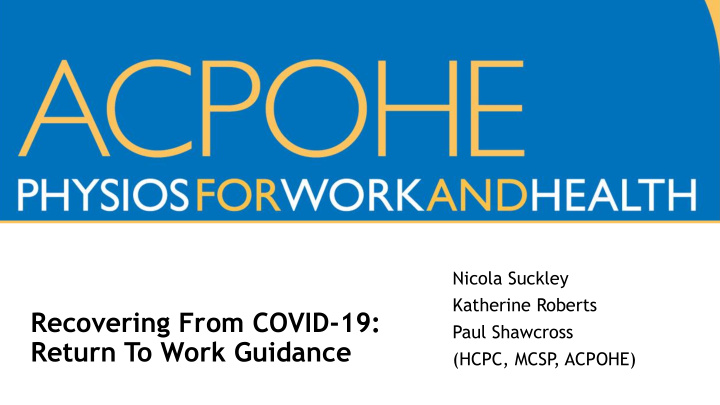



Nicola Suckley Katherine Roberts Recovering From COVID-19: Paul Shawcross Return To Work Guidance (HCPC, MCSP , ACPOHE) ACPOHE
Introduction Association of Chartered Physiotherapist in Occupational Health and Ergonomics (ACPOHE) Established in 1947 - One of the largest sub groups of the Chartered Society of Physiotherapy - (CSP) 350 Members (102 Registered) - Open to all Allied Health Professionals - Welcomes international members - Aims to develop & enhance the quality of OH Physiotherapy in the UK -
Education Occupational Health Essentials’ Online - 9 modules - Other Training courses Online and Face to face - Guidance Documents Evidence based - Study Day/ Conference/ Webinar
COVID-19 Significant impact on global health – directly and indirectly - Symptoms vary in severity - The most common symptoms include: a new continuous cough, high - temperature or loss of, or change in, normal sense of taste or smell High risk groups: people over the age of 60, those with underlying health - conditions and those of BAME origin Lasting post virus symptoms limiting function and RTW - Considerations for health and work - Employees with COVID-19 - Physical and Mental Health of the Overall Workforce - Employees with Additional Health Conditions -
Guidance Document Scope Educate ALL clinicians on how to carryout a work ALL conversation Detail the role of Occupational Health Physiotherapy in OH Team facilitating Return to Work Guide OH Physiotherapists on how to functionally OH Physio rehabilitate employees to return to work post Covid-19
‘Work’ Conversations and the Katherine Roberts Role of OH Physiotherapy (MSc, HCPC, MCSP , ACPOHE) ACPOHE
Myth Busting 1. Do not need to be 100% fit to RTW 2. Fit note not required to return to their normal duties of work 3. Any fitness for work guidance is 'advisory’ (can be amended by the employee and employer) 4. The AHP Health and Work report can be used for Statutory Sick Pay (SSP) purposes
Poll 1a & 1b ACPOHE
RTW Conversation Ask open questions • Don’t make • presumptions What does their • job actually involve? What do they feel • will help?
Potential Obstacles to Successful RTW
Case Study: Covid Example Work demands shape your rehabilitation goals
Work Factors Potential Psychosocial and Physical Risk Factors Individual Risk Factors Self employment High physical work demands such as bending, - - lifting, twisting Lack of support with RTW - Very high levels of fitness required – aerobic - Isolation/lone working - capacity/endurance, strength, flexibility, Mental health issues balance - Safety critical work (work at height, with - machines)
AHP Fitness for Work Report? • Commonly completed by OT’s and physio’s • Use encouraged by DWP and Dept of Health • Allows more detailed information on employee difficulties and associated recommendations • AHP’s, especially First Contact Practitioners (FCP’s) well placed to discuss work and make recommendations • Can be used as evidence for Statutory Sick Pay (but no other benefits)
Work Adjustments/Modifications Practical, easily understood Specific, Communicate realistic, effectively to timely, and individual and with organisation timescales RECOMMENDATIONS Sensitive to Clinically costs reasoned Think outside the box
Adapting our support for Paul Shawcross (HCPC, MCSP , ACPOHE) employees during the pandemic ACPOHE
Specialist OH Physiotherapy Key skills: Rehabilitation Goals Fitness for Work Assessments 1. Physical capacity e.g. strength and cardiovascular Analysis of Job Demands fitness Functional Testing 2. Mental capacity e.g. decreasing the fear of returning to work Functional Rehabilitation Return-to-Work Programmes 3. Functional abilities e.g. bending, lifting, reaching movements specific to the job Return-to-Work Planning
Functional Testing Objective measures: Duration of the Metres walked / Pain score test completed number of lifts? Rate of Perceived Heart rate? Exertion
Functional Testing over video Functional testing over video: static bending
Functional Rehabilitation Case Study: - Absent for 4 weeks after suffering with COVID-19. Recovered well but still has some fatigue symptoms - Works as a platform host, dispatching trains for a rail company - Keen to return to work but worried about ability to complete a full shift based on fatigue symptoms
Graded Physical Activity What about symptoms of fatigue? Pace Plan Prioritise
Mental Health Support Someone to listen Reassurance Communication with the workplace Involve in shared decisions about their health Lifestyle advice Signposting – healthcare and resources
Key Messages Work conversation crucial – should start at beginning of care - Ask about work demands - be clear what a person really does - Shape rehabilitation goals based on specific work demands - Understand potential obstacles to successful RTW (blue and black flags) - Utilise AHP Health and Work Report - Refer patient on for specialist Occupational Health assessment when needed - Consider further developing your own skills in Occupational Health - Contact ACPOHE for support with OH Education and Training -
Poll 2 ACPOHE
Website Thank you for listening acpohe.csp.org.uk Any questions? Email acpohe@buryphysio.co.uk ACPOHE
Recommend
More recommend